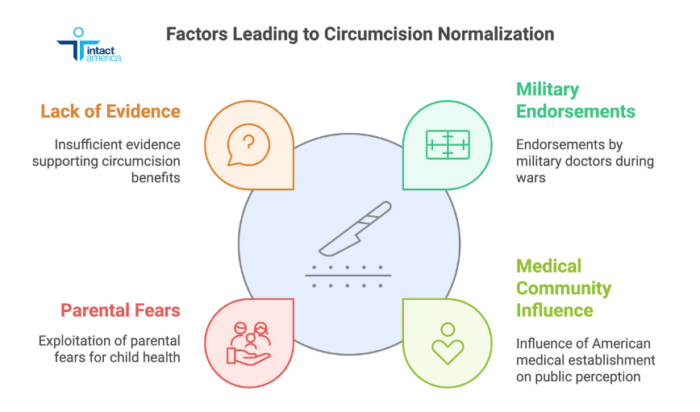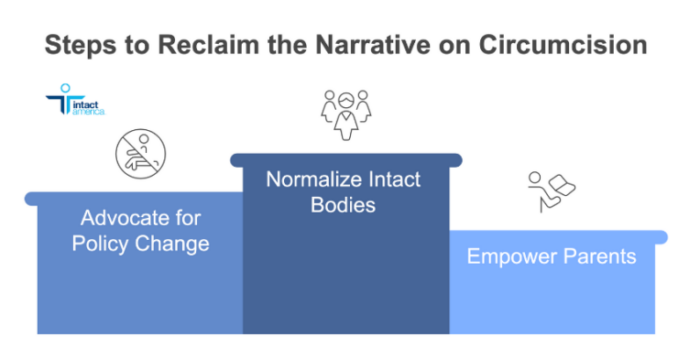
Circumcision is a cultural juggernaut built on a century of propaganda. For many, it’s a practice so normalized that questioning it feels almost heretical.
But peel back the layers, and you’ll find a disturbing history of manipulation, misinformation, and outright lies that have turned an unnecessary and irreversible surgery into a societal expectation.
Here, we expose the five biggest propaganda campaigns that normalized circumcision in Western society, revealing the absurd myths they were built on. We’ll also explore how to undo this harmful legacy with truth, education, and advocacy.
1. The Masturbation Scare: Weaponizing Shame

In the 19th century, the medical establishment declared war on masturbation. Prominent doctors like John Harvey Kellogg (yes, the cereal guy) and Lewis Sayre championed circumcision as a cure for “onanism,” a supposed disease associated with moral decay, physical weakness, and even insanity. By removing the foreskin—considered by these “experts” to be the source of sexual temptation—parents could “save” their children from moral corruption.
What’s wild is how pseudoscientific this claim was. There was no evidence that circumcision prevented masturbation or its alleged consequences, yet the practice gained traction among the prudish upper classes.
This propaganda worked because it played into deeply ingrained religious and cultural fears around sex, using shame as a weapon to justify the procedure.
👉 How to Undo It: Educate people about the historical absurdity of these claims. Normalize conversations around bodily autonomy and sexual health. Publicly reject the lingering shame-based narratives that treat normal sexual behavior as a problem.
2. The Hygiene Hoax: Selling Fear of the Foreskin

In the early 20th century, circumcision was repackaged as a matter of hygiene.
During World War I and World War II, military doctors began promoting circumcision among soldiers, claiming it reduced the risk of infections like STIs. This messaging trickled into civilian life, bolstered by the rising influence of the American medical establishment.
Parents were bombarded with the idea that the foreskin was inherently dirty—a ticking time bomb of disease. Circumcision was framed as a preventive measure against everything from urinary tract infections to cancer, despite scant evidence to support these claims.
This campaign succeeded because it exploited parental fears about their child’s health. By labeling the foreskin as a problem, the medical community created a demand for a solution—one that conveniently required a lucrative surgical intervention.
👉 How to Undo It: Share accurate, science-backed information about the foreskin’s role in protecting and enhancing genital health. Highlight the global context: most men worldwide remain intact without experiencing the supposed “hygiene crises” that fueled this narrative.
3. The “Modern Medicine” Mirage: Institutionalizing the Practice

In the mid-20th century, circumcision became a routine part of hospital births in the United States. Insurance companies covered the procedure, and medical professionals began promoting it as a standard of care. It was marketed not as a choice, but as an expectation.
This institutionalization created a powerful cycle: parents circumcised their sons because “everyone else did,” and doctors recommended it because it was easy, profitable, and widely accepted. Few questioned the ethics of performing irreversible surgery on non-consenting infants.
The veneer of medical legitimacy made circumcision nearly impossible to challenge. The message was clear: if doctors say it’s necessary, who are you to question them?
👉 How to Undo It: Push for transparency in medical practices. Advocate for the classification of infant circumcision as a non-essential, cosmetic procedure. Demand informed consent policies that emphasize the risks and lack of necessity.
4. The STI Scaremongering Campaign: Rebranding Circumcision as Prevention
 In the late 20th and early 21st centuries, circumcision’s image got a makeover as a tool for STI prevention—particularly HIV.
In the late 20th and early 21st centuries, circumcision’s image got a makeover as a tool for STI prevention—particularly HIV.
Large-scale studies in sub-Saharan Africa suggested that circumcision reduced HIV transmission in heterosexual men. Public health organizations latched onto these findings, promoting circumcision as a “solution” to the global AIDS crisis.
But here’s the catch: these studies were region-specific and didn’t account for cultural, social, or behavioral differences. They also didn’t apply to countries like the U.S., where HIV is more often transmitted through other means. Despite these limitations, the narrative spread like wildfire, further entrenching circumcision as a public health measure.
👉 How to Undo It: Challenge the overgeneralization of these studies. Highlight the effectiveness of less invasive preventive measures like condoms and education. Encourage critical thinking about how circumcision is often framed as a quick fix for systemic health issues.
5. The “Cultural Tradition” Excuse: Silencing Dissent

One of the most insidious forms of circumcision propaganda is the claim that it’s a deeply ingrained cultural or religious tradition that must be respected. This narrative shuts down critical discussions, framing opposition as an attack on heritage or faith.
While it’s true that circumcision has roots in some religious practices, its widespread adoption in the West was driven by secular and medical propaganda—not ancient tradition.
However, by framing circumcision as untouchable due to its perceived cultural significance, proponents have stifled meaningful debate about its ethical implications.
👉 How to Undo It: Separate tradition from propaganda. Encourage respectful discussions that prioritize individual rights over collective customs. Emphasize that questioning circumcision isn’t an attack on culture—it’s a defense of bodily autonomy.
The Path Forward: Reclaiming the Narrative
Undoing more than a century of circumcision propaganda won’t happen overnight, but progress is possible. Here are three actionable steps to challenge the status quo:

a. Normalize Intact Bodies
Promote the idea that the foreskin is a natural, functional part of the body—not a medical defect. Media campaigns, parenting resources, and educational materials should celebrate bodily integrity.
b. Advocate for Policy Change
Push for laws that protect infants from non-consensual circumcision. Countries like Iceland have already proposed banning the practice on minors, citing human rights concerns. The U.S. can—and should—follow suit.
c. Empower Parents
Equip parents with factual, unbiased information about circumcision. Create spaces where they can ask questions without judgment or pressure from medical professionals.
Conclusion: Unveiling the Lies
Circumcision’s normalization is a textbook example of how propaganda can manipulate a society. From shaming masturbation to scaremongering about hygiene and STIs, each campaign has used fear, misinformation, and social pressure to turn a harmful practice into a norm.
The good news? These lies can be unraveled. By spreading awareness, fostering open dialogue, and advocating for change, we can dismantle the myths that have propped up circumcision for generations—and protect future children from being subjected to it without their consent. It’s time to reclaim the narrative and champion the right to bodily autonomy for all.
Join us in defending bodily autonomy—every boy deserves control over his own body.









Dan Bollinger
November 23, 2024 10:42 amI like this narrative! A lot! It encapsulates the various cultural forces at work. And it highlights why opposing the practice is so difficult because there are so many facets. I think of it as the Gordian Knot of children’s rights.